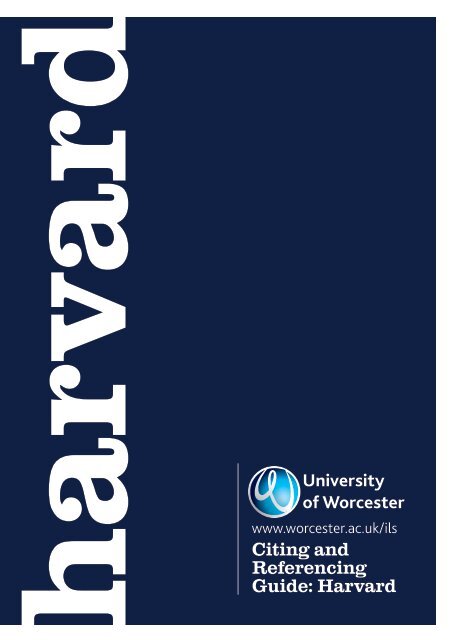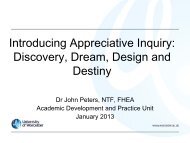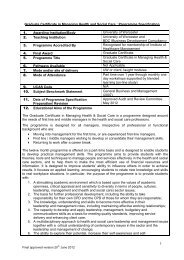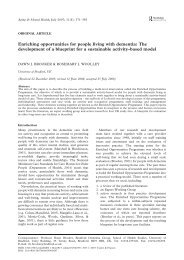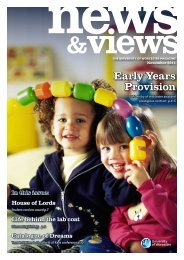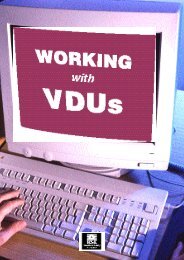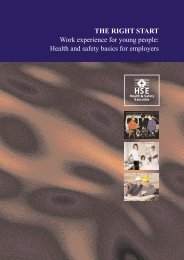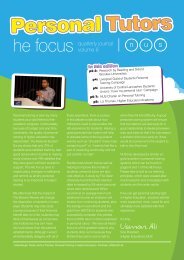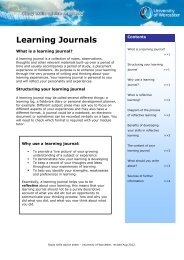Citing and Referencing Guide: Harvard - University of Worcester
Citing and Referencing Guide: Harvard - University of Worcester
Citing and Referencing Guide: Harvard - University of Worcester
Create successful ePaper yourself
Turn your PDF publications into a flip-book with our unique Google optimized e-Paper software.
harvard<br />
<strong>University</strong><br />
<strong>of</strong> <strong>Worcester</strong><br />
www.worcester.ac.uk/ils<br />
<strong>Citing</strong> <strong>and</strong><br />
<strong>Referencing</strong><br />
<strong>Guide</strong>: <strong>Harvard</strong>
Contents<br />
<strong>Citing</strong> ...................................................................................................................................................................................... 2<br />
What does citing look like ................................................................................................................................................. 2<br />
Paraphrasing & Summarising ............................................................................................................................................ 3<br />
Direct quote ........................................................................................................................................................................... 3<br />
Two separate publications with the same author(s) <strong>and</strong> same year ............................................................................ 4<br />
<strong>Citing</strong> from chapters written by different authors............................................................................................................. 4<br />
Secondary referencing ........................................................................................................................................................ 5<br />
Including Visual Materials in your work ............................................................................................................................ 5<br />
Reference list ........................................................................................................................................................................ 6<br />
Layout for each type <strong>of</strong> publication .................................................................................................................................... 9<br />
Books ................................................................................................................................................................................. 9<br />
Chapters in books ............................................................................................................................................................ 9<br />
Books accessed online (e-books)................................................................................................................................ 10<br />
Books that have been translated ................................................................................................................................. 10<br />
Books written in a foreign language ............................................................................................................................ 11<br />
Journal articles ............................................................................................................................................................... 11<br />
Journal articles accessed online (e-journal articles) ................................................................................................. 11<br />
Independent Studies, Dissertations <strong>and</strong> Theses ...................................................................................................... 12<br />
Newspaper articles ........................................................................................................................................................ 12<br />
Conference proceedings ............................................................................................................................................... 13<br />
Acts <strong>of</strong> Parliament .......................................................................................................................................................... 13<br />
White <strong>and</strong> Green papers ............................................................................................................................................... 14<br />
Reports ............................................................................................................................................................................ 14<br />
Market Reports ............................................................................................................................................................... 15<br />
Maps................................................................................................................................................................................. 15<br />
Webpages ....................................................................................................................................................................... 15<br />
Multimedia ....................................................................................................................................................................... 16<br />
Images, photos, charts <strong>and</strong> figures ............................................................................................................................. 18<br />
Materials from Lectures <strong>and</strong> VLEs .............................................................................................................................. 19<br />
1
<strong>Citing</strong><br />
In your assignment, when you have used an idea or a quote from a book, journal article or other source you<br />
must acknowledge this in your text. We refer to this as ‘citing’.<br />
What does citing look like<br />
In your text, a citation will usually follow the format author-year <strong>of</strong> publication. It is very rarely different; an<br />
‘author’ is the person or organisation/department who created, wrote or produced the work. If you use a direct<br />
quote, you will additionally include a page number, where available. There is flexibility in where you put a<br />
citation, but not what you put into it.<br />
Incorrect Correct Why<br />
Haylock, D. (2006) Haylock (2006) Don’t need an initial, this will<br />
be in your reference list.<br />
Haylock & Thangata (2007)<br />
define differentiation as<br />
“ways in which teachers take<br />
into account in their planning<br />
<strong>and</strong> teaching the differences<br />
between the pupils in the<br />
class”.<br />
http://www.autism.org.uk<br />
(2010)<br />
DfE (2011)<br />
The use <strong>of</strong> rods, blocks <strong>and</strong><br />
coins can be useful in<br />
teaching place value to<br />
children. (Haylock 2006)<br />
Littleford, Halstead <strong>and</strong><br />
Mulraine (2004)<br />
Pears, Shields (2010)<br />
Pears + Shields (2010)<br />
Haylock & Thangata (2007:<br />
p.57) define differentiation as<br />
“ways in which teachers take<br />
into account in their planning<br />
<strong>and</strong> teaching the differences<br />
between the pupils in the<br />
class”.<br />
National Autistic Society<br />
(2010)<br />
Department for Education<br />
(DfE) (2011)<br />
The use <strong>of</strong> rods, blocks <strong>and</strong><br />
coins can be useful in<br />
teaching place value to<br />
children (Haylock 2006).<br />
Littleford et al. (2004)<br />
Pears <strong>and</strong> Shields (2010)<br />
Pears & Shields (2010)<br />
Direct quotes should be cited<br />
in the text with a page<br />
number (if available) for the<br />
page where it appeared, so<br />
the reader can locate the<br />
quote.<br />
Don’t use a website address.<br />
You can use a corporate<br />
author, when there is no<br />
named person for the work<br />
you are citing.<br />
The first time you use an<br />
acronym, it is good practice<br />
to provide the full name too.<br />
Full stop should be after the<br />
citation, otherwise it<br />
becomes ‘detached’.<br />
Do not list three or more<br />
authors. Instead include the<br />
surname <strong>of</strong> the first author,<br />
then write ‘et al’. Remember<br />
to list all authors in your<br />
reference list.<br />
You may use ‘<strong>and</strong>’ or an<br />
ampers<strong>and</strong> ‘&’ but don’t mix<br />
them up – pick one method<br />
<strong>and</strong> be consistent.<br />
2
Paraphrasing & Summarising<br />
What is it Writing another author's idea or findings in your own words. You may paraphrase a quote or short<br />
paragraph in to your own words, making it more meaningful within the context <strong>of</strong> your work. You may also<br />
summarise the content <strong>of</strong> a longer passage <strong>of</strong> text, such as an article or a report, or write about a seminal<br />
piece <strong>of</strong> work, policy or theory in your subject area.<br />
Why do it You are demonstrating that you have understood what you have read. Paraphrasing <strong>and</strong><br />
summarising enables you to include supporting or contrasting evidence in your work in a more creative,<br />
flowing way.<br />
Examples:<br />
Pears <strong>and</strong> Shields (2010) <strong>of</strong>fer tips to help students avoid plagiarism, including good time management, the<br />
use <strong>of</strong> quotation marks for direct quotes, <strong>and</strong> making full notes <strong>of</strong> all reference details for every source.<br />
It is important to choose a research topic which you are likely to be interested in for a long period <strong>of</strong> time, <strong>and</strong><br />
think through all the potential difficulties <strong>of</strong> researching that topic before you commit to it (Bell 2010).<br />
The literature on academic skills <strong>of</strong>fers a variety <strong>of</strong> tips on reading effectively, including: underlining to focus<br />
your attention on the text, questioning what is being read, summarising chunks <strong>of</strong> reading, <strong>and</strong> categorising<br />
different sources to give purpose to what you are reading (Northedge 2005; Creme <strong>and</strong> Lea 2008; Grix <strong>and</strong><br />
Watkins 2010).<br />
Direct quote<br />
What is it Using an actual quote from a source to back up your perspectives, discussions, ideas or<br />
arguments. Remember to use quotation marks.<br />
Why do it Demonstrates the breadth <strong>of</strong> your reading. Sometimes the author's own words say it best.<br />
However, quotes can break the flow <strong>of</strong> your writing if you use them too <strong>of</strong>ten. You should start long quotes <strong>of</strong><br />
three lines or more in a new, indented paragraph.<br />
Examples:<br />
Collecting <strong>and</strong> reading through assignment feedback is a valuable <strong>and</strong> important part <strong>of</strong> learning, however<br />
Race (2007: p.32) suggests that regular self-assessment is also crucial, so that a student can “identify in good<br />
time those elements that will be the most valuable <strong>and</strong> important areas to which to devote additional time <strong>and</strong><br />
effort”.<br />
Race (2007: p.32) emphasises the benefits <strong>of</strong> self-testing:<br />
“It is more or less assumed that motivated students will organize for themselves the actions <strong>and</strong> processes<br />
which lead to making sense <strong>of</strong> what they are learning. The best ways <strong>of</strong> checking that you are making sense<br />
<strong>of</strong> what you have been learning is to test yourself out with it. Practice at testing yourself is ideal rehearsal for<br />
formal assessments too.”<br />
Alternatively, the citation can go at the end:<br />
“It is more or less assumed that motivated students will organize for themselves the actions <strong>and</strong> processes<br />
which lead to making sense <strong>of</strong> what they are learning. The best ways <strong>of</strong> checking that you are making sense<br />
<strong>of</strong> what you have been learning is to test yourself out with it. Practice at testing yourself is ideal rehearsal for<br />
formal assessments too.”<br />
Race (2007: p.32)<br />
3
To omit part <strong>of</strong> a quote, you can use three dots (…). This is called ellipsis:<br />
“ ‘Formative feedback’ … can help you develop your approach, <strong>and</strong> fine-tune your efforts towards getting that<br />
good degree” (Race 2007: p.87).<br />
Sometimes you will want to use a quote from a webpage. If there is no page number available, you cannot<br />
include one. Your reference list should <strong>of</strong>fer your reader a direct link to the webpage which displays the quote.<br />
Two separate publications with the same author(s) <strong>and</strong> same year<br />
If you cite a new source which has the same author <strong>and</strong> was written in the same year as an earlier citation,<br />
you must use a lower case letter after the date to differentiate between the two.<br />
Examples:<br />
Good relationships with parents are crucial in tackling a child's poor behaviour. Dukes <strong>and</strong> Smith (2009a: p.28)<br />
explain how these might be nurtured: "Mutual respect, a valuing <strong>of</strong> diversity <strong>and</strong> effective communication are<br />
essential to forming good relationships with parents."<br />
Dukes <strong>and</strong> Smith (2009b) suggest several methods <strong>of</strong> communicating with parents, such as regular meetings,<br />
diaries, observations <strong>and</strong> records.<br />
In the reference list:<br />
Dukes, C. <strong>and</strong> Smith, M. (2009a) Building better behaviour in the early years. London, SAGE.<br />
Dukes, C. <strong>and</strong> Smith, M. (2009b) Recognising <strong>and</strong> planning for special needs in the early years. London,<br />
SAGE.<br />
<strong>Citing</strong> from chapters written by different authors<br />
Some books may contain chapters written by different authors. When citing work from such a book, the<br />
author(s) who wrote the chapter should be cited, not the editor(s) <strong>of</strong> the book.<br />
Example:<br />
Buckler <strong>and</strong> Hobbs (2009) advise students that the learning process can be very different at university.<br />
In the reference list:<br />
Buckler, L. <strong>and</strong> Hobbs, S. (2009) <strong>University</strong> life: the student perspective. In: Doughty, R. <strong>and</strong> Shaw, D. (eds.)<br />
Film: the essential study guide. Abingdon, Routledge, pp. 15-24.<br />
4
Secondary referencing<br />
What is it Pears <strong>and</strong> Shields (2010: p.8) explain:<br />
"In some cases you will read a source that refers to the work <strong>of</strong> somebody else, known as a secondary<br />
source. Probably you should find <strong>and</strong> read the item referred to. However, where this is not possible <strong>and</strong> you<br />
still wish to include the work referred to, you can only mention it as a citation, known as secondary<br />
referencing”.<br />
Why do it You'll need to do it when you cannot locate the original source. You are advised to read the original<br />
source, so that you can see the context for yourself <strong>and</strong> view it without the perspective <strong>of</strong> a second author.<br />
However, sometimes this is not possible, particularly in cases where you are discussing well-established<br />
theories <strong>and</strong> ideas which were published many years ago; the original sources will be very hard to acquire. In<br />
your reference list, you only include the source you have used, not the original secondary source.<br />
Example:<br />
Vygotsky (1931) cited by Langford (2005: p.48) discusses pattern recognition by infants: “For the infant,<br />
objects are divided into objects to recognise, to grasp, etc., that is they are distinguished according to different<br />
sensory patterns”.<br />
Including Visual Materials in your work<br />
Duplication <strong>of</strong> charts, diagrams, pictures etc. should be treated as direct quotes, in that the author(s) should be<br />
acknowledged <strong>and</strong> page numbers shown both in your text where the diagram is discussed or introduced, <strong>and</strong><br />
in the caption you write for it. You are also advised to ask your tutors in your Institute about whether there is a<br />
policy or guidance on reproducing a table <strong>of</strong> figures/illustrations in your work, alongside the reference list.<br />
Let’s say you’re discussing UK populations <strong>and</strong> want to include the chart below that you have found. This chart<br />
would need to be given its own caption to show where the chart is from, referenced properly in your<br />
reference list <strong>and</strong> cited in your text.<br />
Example:<br />
Figure 1 (Office <strong>of</strong> National Statistics 2011) indicated that…<br />
Figure 1: UK Population (Source: Office for National Statistics 2011)<br />
In your reference list:<br />
Office for National Statistics (2011) Population. [Online]. Available from:<br />
http://www.statistics.gov.uk/cci/nugget.aspid=6 [Accessed 19 th April 2011].<br />
5
Reference list<br />
This is your list <strong>of</strong> all the sources that have been cited in the assignment. It is inclusive, showing books,<br />
journals <strong>and</strong> other sources in one comprehensive list (not separated into source type).<br />
• The list should be in alphabetical order by author/editor.<br />
• Sources are laid out in a particular format that must be followed.<br />
• Apart from the first word, all other words in book <strong>and</strong> article titles begin with lower case<br />
letters, except for proper nouns such as cities, countries <strong>and</strong> names.(Note this does not<br />
apply to journal titles).<br />
• A bibliography follows the same layout as a reference list, but is used to list all the<br />
sources you consulted for your work, but did not cite (You should check with tutors<br />
whether an additional bibliography is acceptable; many tutors will only want you to include<br />
a reference list).<br />
What does a reference list look like<br />
Start with a title – Reference List – <strong>and</strong> then list all the sources you have cited in your work, in alphabetical<br />
order by author.<br />
Reference List<br />
Bell, J. (2010) Doing your research project: a guide for first-time researchers in education, health <strong>and</strong> social<br />
science. 5 th edition. [e-book] Maidenhead, Open <strong>University</strong> Press. Available from: My iLibrary [Accessed 12 th<br />
April 2011].<br />
Buckler, L. <strong>and</strong> Hobbs, S. (2009) <strong>University</strong> life: the student perspective. In: Doughty, R. <strong>and</strong> Shaw, D. (eds.)<br />
Film: the essential study guide. Abingdon, Routledge, pp. 15-24.<br />
Cassaday, H.J., Bloomfield, R.E. <strong>and</strong> Hayward, N. (2002) Relaxed conditions can provide memory cues in<br />
both undergraduates <strong>and</strong> primary school children. British Journal <strong>of</strong> Educational Psychology, 72 (4), 531-547.<br />
Creme, P. <strong>and</strong> Lea, M.R. (2008) Writing at university: a guide for students. 3 rd edition. [e-book] Maidenhead,<br />
Open <strong>University</strong> Press. Available from: My iLibrary [Accessed 12 th April 2011].<br />
Dukes, C. <strong>and</strong> Smith, M. (2009a) Building better behaviour in the early years. London, SAGE.<br />
Dukes, C. <strong>and</strong> Smith, M. (2009b) Recognising <strong>and</strong> planning for special needs in the early years. London,<br />
SAGE.<br />
Grix, J. <strong>and</strong> Watkins, G. (2010) Information skills: finding <strong>and</strong> using the right resources. Basingstoke, Palgrave<br />
Macmillan.<br />
Langford, P.E. (2005) Vygotsky’s developmental <strong>and</strong> educational psychology. [e-book] Hove/New York,<br />
Psychology Press. Available from: My iLibrary [Accessed 12 th April 2011].<br />
Mintel (2011) Car Buying – UK – March 2011. [Online]. Available from: Mintel [Accessed 7 th April 2011].<br />
Northedge, A. (2005) The good study guide. 2 nd edition. Milton Keynes, Open <strong>University</strong> Press.<br />
Pears, R. <strong>and</strong> Shields, G. (2010) Cite them right: the essential referencing guide. 8 th edition. Basingstoke,<br />
Palgrave Macmillan.<br />
Race, P. (2007) How to get a good degree: making the most <strong>of</strong> your time at university. 2 nd edition. [e-book]<br />
Maidenhead, Open <strong>University</strong> Press. Available from: My iLibrary [Accessed 12 th April 2011].<br />
6
Top tips for good referencing<br />
When making notes about your reading, always write down the basic source details: author, date, title,<br />
page number (especially for quotes), <strong>and</strong> where needed, website address <strong>and</strong>/or journal title/volume/issue.<br />
This saves time later <strong>and</strong> helps you to avoid accidental plagiarism.<br />
Consider using different colours for your notes. For example, you might use black for your own ideas,<br />
green for quotes <strong>and</strong> blue for paraphrasing/summarising.<br />
Try to create your reference list as you are writing your assignment. Leaving it until the last minute makes<br />
the task more difficult <strong>and</strong> time-consuming. If you do it using a word processor, you can copy/paste the<br />
references into your assignments later.<br />
Be consistent in your use <strong>of</strong> punctuation <strong>and</strong> in the layout <strong>of</strong> each source type. For example: use either<br />
an ampers<strong>and</strong> (&) or the word ‘<strong>and</strong>’ to list multiple authors in your reference list. Normally, authors are<br />
listed using surname <strong>and</strong> initial(s) only, but you may wish to include the full first name. Pick your preferred<br />
methods <strong>and</strong> then use them consistently throughout your reference list.<br />
If you are unsure how to reference a particular source, then try to answer the following questions:<br />
o Who is the author (Person(s) or organisation as corporate author)<br />
o When is the date (year) <strong>of</strong> publication<br />
o What is the title<br />
o Is there a place <strong>of</strong> publication<br />
o Is there a publisher<br />
These are the basic elements you need when referencing any source. If you can find an answer for each<br />
question, then you should be able to put together a reference. Additional information is needed where the<br />
source is online (usually a URL <strong>and</strong> a date <strong>of</strong> access), or where the source is within a collection (for<br />
example, a chapter in an edited book, or an article in a journal). Some online sources, e.g. webpages, will<br />
not have a place <strong>of</strong> publication or a publisher – so you don’t need to include them.<br />
Remember that your reader must be able to link the citation in your text to the full reference in your<br />
reference list, so that they can locate the original source. Therefore, your author(s) <strong>and</strong> year must be the<br />
same in your citation <strong>and</strong> in your reference list. PROOF-READING is essential; read it aloud, does it<br />
make sense Any spelling mistakes Missing punctuation Do your quotes, paraphrases <strong>and</strong> citations<br />
flow<br />
Can’t find where a particular quote came from Can’t remember the title <strong>of</strong> the book you used All is not<br />
lost. Try searching Google (www.google.co.uk) <strong>and</strong> My iLibrary e-books. You can use quotation marks (“)<br />
to help you track down a quote. The library catalogue can also provide reference details, particularly for<br />
books. You can view your Loan History through your online library account too.<br />
The <strong>University</strong> <strong>of</strong> <strong>Worcester</strong> referencing guidance cannot give examples for every type <strong>of</strong> source that’s out<br />
there. Sometimes you need to be creative <strong>and</strong> consistent in your methods. Consider using a<br />
comprehensive guide to referencing to help you devise the best solution, such as Pears <strong>and</strong> Shields (2010)<br />
(reference below).<br />
7
If you would like more advice about referencing, the following book may be useful:<br />
Neville, C. (2010) The complete guide to referencing <strong>and</strong> avoiding plagiarism. 2 nd edition. Maidenhead,<br />
Open <strong>University</strong> Press.<br />
If you get stuck, ask for help. Academic Liaison Librarians <strong>and</strong> your tutors can advise on referencing.<br />
Email: askalibrarian@worc.ac.uk<br />
See also the Pebblepad website created by Sarah Oxford, Education Librarian. It <strong>of</strong>fers further examples<br />
<strong>and</strong> responses to questions the librarian team get from students. http://tinyurl.com/2cdgpus<br />
This guide has been created with reference to the following source, where required: Pears, R. <strong>and</strong><br />
Shields, G. (2010) Cite them right: the essential referencing guide. 8 th edition. Basingstoke, Palgrave<br />
Macmillan.<br />
8
Layout for each type <strong>of</strong> publication<br />
Books<br />
Author(s): normally surname <strong>and</strong> initial(s). List all authors (do not use et al. in the reference list). Use<br />
ampers<strong>and</strong> (&) or ‘<strong>and</strong>’ – pick one method <strong>and</strong> be consistent throughout.<br />
Year <strong>of</strong> publication: in brackets<br />
Title: in italics<br />
Series title <strong>and</strong> number: if part <strong>of</strong> a series<br />
Edition: if not the first edition<br />
Place <strong>of</strong> publication: if there is more than one place listed, use the first one<br />
Publisher<br />
Layout examples:<br />
Newell, R. <strong>and</strong> Burnard, P. (2011) Research for evidence-based practice in healthcare. 2 nd edition.<br />
Oxford, Wiley-Blackwell.<br />
Rittinghouse, J.W. <strong>and</strong> Ransome, J.F. (2010) Cloud computing: implementation, management, <strong>and</strong><br />
security. Boca Raton, Florida, CRC Press.<br />
Chapters in books<br />
Author(s) <strong>of</strong> the chapter<br />
Year <strong>of</strong> publication: in brackets<br />
Title <strong>of</strong> chapter<br />
In:<br />
Editor(s) <strong>of</strong> book<br />
(ed.) or (eds.) to represent editor or editors, if more than one<br />
Title <strong>of</strong> book: in italics<br />
Series title <strong>and</strong> number: if part <strong>of</strong> a series<br />
Edition: if not the first edition<br />
Place <strong>of</strong> publication: if there is more than one place listed, use the first one<br />
Publisher<br />
Page(s) where the chapter is located: Usually a page range. Use ‘p.’ before a single page number<br />
<strong>and</strong> ‘pp.’ where there are multiple pages<br />
Layout examples: (see next section for an e-book example)<br />
Eliot, S. (2010) History <strong>of</strong> the book. In: Da Sousa Correa, D. <strong>and</strong> Owens, W.R. (eds.) The h<strong>and</strong>book to<br />
literary research. 2nd edition. Abingdon, Routledge, pp. 49-68.<br />
Parker, C. (2004) The role <strong>of</strong> the state in sport. In: Beech, J. <strong>and</strong> Chadwick, S. (eds.) The business <strong>of</strong><br />
sport management. Harlow, Pearson Education, pp. 43-66.<br />
9
Books accessed online (e-books)<br />
Author(s)<br />
Year <strong>of</strong> publication: in brackets<br />
Title: in italics<br />
Series title <strong>and</strong> number: if part <strong>of</strong> a series<br />
Edition: if not the first edition<br />
[e-book]<br />
Place <strong>of</strong> publication: if there is more than one place listed, use the first one<br />
Publisher<br />
Available from: database name or, if freely available, web address <strong>of</strong> e-book<br />
[Date <strong>of</strong> access]<br />
Layout examples: (NB: first example is for a chapter in an edited book)<br />
Hayes, D. (2010) Pr<strong>of</strong>essionalism <strong>and</strong> trainee teachers. In: Arthur, J. <strong>and</strong> Cremin, T. (eds.) Learning to<br />
teach in the primary school. 2 nd edition. [e-book] Abingdon, Routledge, pp.18-28. Available from:<br />
MyiLibrary [Accessed 12 th April 2011].<br />
Matthews, D.J. (2010) What cats can teach us. [e-book] London, Penguin. (NB: You may wish to use<br />
this for books read on e-readers, such as a Kindle. More recent s<strong>of</strong>tware upgrades for Kindle allow you<br />
to view page numbers for citing purposes.)<br />
Strongman, K.T. (2006) Applying psychology to everyday life: a beginner’s guide. [e-book] Chichester,<br />
John Wiley & Sons. Available from: MyiLibrary [Accessed 12 th April 2011].<br />
Thomas, K.T., Lee, A.M. <strong>and</strong> Thomas, J.R. (2000) Physical education for children: daily lesson plans<br />
for elementary school. 2 nd edition. [e-book] Champaign, IL, Human Kinetics. Available from:<br />
http://books.google.co.uk/booksid=eN1MbmCZs4MC&lpg=PP1&dq=<br />
physical%20education&pg=PP1#v=onepage&q&f=false [Accessed 9th May 2011].<br />
Books that have been translated<br />
Author/Editor: if it is an editor always put (ed.) or (eds.) after the name(s)<br />
Year <strong>of</strong> publication: in brackets<br />
Title: in italics<br />
Trans: followed by the name <strong>of</strong> the person(s) who translated the book<br />
Series title <strong>and</strong> number: if part <strong>of</strong> a series<br />
Edition: if not the first edition<br />
Place <strong>of</strong> publication: if there is more than one place listed, use the first one<br />
Publisher<br />
Layout example:<br />
Höffe, O. (2007) Democracy in an age <strong>of</strong> globalisation. Trans. Haubrich, D. & Ludwig, M. Studies in<br />
Global Justice, volume 3. Dordrecht, Springer.<br />
10
Books written in a foreign language<br />
Author/Editor: if it is an editor always put (ed.) or (eds.) after the name(s)<br />
Year <strong>of</strong> publication: in brackets<br />
Title: in italics<br />
[Title in original language]: in italics<br />
Series title <strong>and</strong> number: if part <strong>of</strong> a series<br />
Edition: if not the first edition<br />
Place <strong>of</strong> publication: if there is more than one place listed, use the first one<br />
Publisher<br />
Layout example:<br />
Milani, F. (2001) The Phantom <strong>of</strong> the Opera. [Le Fantome De L’Opera]. Paris, LeRoux.<br />
Journal articles<br />
Author(s)<br />
Year <strong>of</strong> publication: in brackets<br />
Title <strong>of</strong> article<br />
Title <strong>of</strong> journal: in italics<br />
Volume number<br />
Issue (or part) number: in brackets. Occasionally, no issue number is available<br />
Page number(s) <strong>of</strong> the article: do not use ‘p.’ or ‘pp.’ before page numbers<br />
Layout example:<br />
Cassaday, H.J., Bloomfield, R.E. <strong>and</strong> Hayward, N. (2002) Relaxed conditions can provide memory<br />
cues in both undergraduates <strong>and</strong> primary school children. British Journal <strong>of</strong> Educational Psychology,<br />
72 (4), 531-547.<br />
Journal articles accessed online (e-journal articles)<br />
Author(s)<br />
Year <strong>of</strong> publication: in brackets<br />
Title <strong>of</strong> journal article<br />
Title <strong>of</strong> journal: in italics<br />
[Online]<br />
Volume number<br />
Issue number: in brackets. Occasionally, no issue number is available<br />
Page numbers <strong>of</strong> the article: do not use ‘p.’ or ‘pp.’ before page numbers<br />
Available from: database name or, if freely available, website address <strong>of</strong> online journal<br />
[Date <strong>of</strong> access]<br />
Layout examples:<br />
Englebrecht, F. & Wendt, T. (2008) Detecting sugar: an everyday problem when facing diabetes.<br />
Science in School. [Online] 9, 22-27. Available from: http://www.scienceinschool.<br />
org/repository/docs/issue9_diabetes.pdf [Accessed 12 th November 2010].<br />
Gillenwater, P.J. & Kaelin, M. (2008) Take your new team to the top. Journal <strong>of</strong> Accountancy. [Online]<br />
205 (3), 58-60. Available from: Business Source Premier [Accessed 11 th November 2010].<br />
11
Independent Studies, Dissertations <strong>and</strong> Theses<br />
You may reference PhD theses, <strong>and</strong> dissertations, project reports, discourses <strong>and</strong> essays (MSc, MA, BSc <strong>and</strong><br />
BA) using the information below.<br />
Author<br />
Year <strong>of</strong> publication: in brackets<br />
Title: in italics<br />
Type <strong>of</strong> thesis: e.g. PhD thesis<br />
Academic institution<br />
Layout example:<br />
Webber, A. (2007) The concept <strong>of</strong> the female body in a selection <strong>of</strong> writing by Margaret Atwood <strong>and</strong><br />
Carol Ann Duffy. BA (Hons). <strong>University</strong> <strong>of</strong> <strong>Worcester</strong>.<br />
Newspaper articles<br />
Paper copy<br />
Reporter: if there is no reporter use the name <strong>of</strong> the newspaper as a corporate author.<br />
Full date <strong>and</strong> year <strong>of</strong> publication: in brackets<br />
Title <strong>of</strong> article<br />
Title <strong>of</strong> newspaper: in italics<br />
Page number(s) <strong>of</strong> the article: use ‘p.’ before a single page number <strong>and</strong> ‘pp.’ where there are multiple<br />
pages<br />
Layout example:<br />
Kidderminster Shuttle (Thursday 22 nd July 2010) Second school uses 'lolli-cam'. Kidderminster Shuttle,<br />
p.5.<br />
Termlett, G. (Thursday 12 th May 2011) Spanish city struck by deadly earthquake. The Guardian, p.19.<br />
Online copy (may also be used for items on news websites)<br />
Reporter: if there is no reporter use the name <strong>of</strong> the newspaper as a corporate author.<br />
Full date <strong>and</strong> year <strong>of</strong> publication: in brackets<br />
Title <strong>of</strong> article<br />
Title <strong>of</strong> Newspaper/news website: in italics<br />
[Online]<br />
Page number(s) <strong>of</strong> article if available: use ‘p.’ before a single page number <strong>and</strong> ‘pp.’ when there are<br />
multiple pages.<br />
Available from: newspaper database name or web address <strong>of</strong> news item<br />
[Date <strong>of</strong> access]<br />
Layout examples:<br />
Baker, M. (Saturday 19 th June 2010) Schools 'in a curriculum vacuum'. BBC News. [Online] Available<br />
from: http://www.bbc.co.uk/news/10355207 [Accessed 27 th July 2010].<br />
Barker, I. (Friday 25 th June 2010) Two-thirds <strong>of</strong> TAs engaged in 'active teaching'. The Times<br />
Educational Supplement. [Online] Available from: http://www.tes.co.uk/article.aspxstorycode=6048531<br />
[Accessed 28 th July 2010].<br />
Reynard, A. (Tuesday 11 th March 2008) There are lessons only parents can teach. The Daily<br />
Telegraph. [Online] p.20. Available from: Lexis Library. [Accessed 5 th April 2012].<br />
12
Conference proceedings<br />
Online materials<br />
Author(s)/Presenter(s)<br />
Year: in brackets<br />
Title <strong>of</strong> paper: in italics<br />
[Online]<br />
Conference title:<br />
Location <strong>of</strong> conference<br />
Day(s) <strong>and</strong> month <strong>of</strong> conference<br />
Available from: website address<br />
[Date <strong>of</strong> access]<br />
Layout examples:<br />
Whetton, C. <strong>and</strong> Sainsbury, M. (2007) E-assessment for improving learning. [Online] 33 rd International<br />
Association for Educational Assessment Conference. Baku, Azerbaijan, 16-21 September. Available<br />
from: http://www.nfer.ac.uk/nfer/publications/44405/44405.pdf [Accessed 28 th July 2010].<br />
Published proceedings (print)<br />
Author(s)/Presenter(s)<br />
Year: in brackets<br />
Title <strong>of</strong> conference paper<br />
followed by In:<br />
Editor(s): followed by (ed.) or (eds.)<br />
Title <strong>of</strong> publication: in italics<br />
Place <strong>of</strong> publication<br />
Publisher<br />
Page number(s) <strong>of</strong> paper: use ‘p.’ before a single page number <strong>and</strong> ‘pp.’ when there are multiple<br />
pages.<br />
Layout example:<br />
Dombey, H. (2002) Making the case: why we need to teach children the regularities <strong>of</strong> our spelling<br />
system. In: Cook, M. (ed.) Perspectives on the Teaching <strong>and</strong> Learning <strong>of</strong> Phonics: Papers from two<br />
conferences held by the United Kingdom Reading Association in 1999 <strong>and</strong> 2000. Royston, UKRA, pp.<br />
14-28.<br />
Acts <strong>of</strong> Parliament<br />
Author: Acts <strong>of</strong> Parliament have a Corporate Author, which is Parliament itself. This should be<br />
displayed as Great Britain if it needs to be distinguished from Acts produced by other Governments. It<br />
is more usual to leave this information out <strong>of</strong> the reference.<br />
Title: in italics. This is the ‘short title’ <strong>of</strong> the Act, which includes the year, with key words capitalised.<br />
Chapter: if required, in brackets<br />
Place <strong>of</strong> publication<br />
Publisher<br />
Layout example:<br />
Disability Discrimination Act 2005. (c.13). London, The Stationary Office.<br />
For Acts prior to 1963, a different system operated based on the date <strong>of</strong> the Sovereign’s accession to the<br />
throne (called the regnal year) <strong>and</strong> the dates <strong>of</strong> the Parliamentary session.<br />
Layout example:<br />
Road Transport Lighting Act 1957. (5&6 Eliz. 2, c.51). London, HMSO.<br />
Education Act 1944. (7&8 Geo. 6, c. 31). London, HMSO.<br />
13
White <strong>and</strong> Green papers<br />
White <strong>and</strong> Green papers are Government consultation papers to inform the debate on new policy <strong>and</strong> laws.<br />
They usually have a CM number you can use as 'paper number'.<br />
Government department<br />
Year <strong>of</strong> publication: in brackets<br />
Title: in italics<br />
Paper number<br />
Place <strong>of</strong> publication<br />
Publisher<br />
Layout examples: (NB: the second example shows an online version, including [Online], URL <strong>and</strong><br />
access date.)<br />
Department <strong>of</strong> Health (2004) Choosing Health: making healthier choices easier. CM6374. London,<br />
TSO (The Stationery Office).<br />
Gove, M. (2010) The importance <strong>of</strong> teaching: the schools White Paper 2010. [Online] CM7980.<br />
London, The Stationery Office. Available from: https://www.education.gov.uk/<br />
publications//eOrderingDownload/CM-7980.pdf [Accessed 27 th May 2011].<br />
Reports<br />
Author*: use the name <strong>of</strong> the organisation or project team if there is no named author<br />
Year <strong>of</strong> publication*: in brackets<br />
Title*: in italics<br />
[Online]: if online<br />
Organisation*<br />
Report number*: if available<br />
Place <strong>of</strong> publication: if available<br />
Publisher: if available<br />
Available from: website address, if online<br />
[Date <strong>of</strong> access]: if accessed online<br />
(NB: All items marked with an asterisk (*) are the basic elements required for a report (see example 1).<br />
However, you may find that you are able to reference an online document much like a website or as a book (if<br />
it has been published). You can only use the information available to you; remember to be consistent <strong>and</strong><br />
ensure that your reader can make the connection between your citation, your reference <strong>and</strong> the original<br />
source.)<br />
Layout examples:<br />
Online report:<br />
Morgan, Dr. R. (2011) Younger children’s views. [Online] Ofsted. Report number: 100094. Available<br />
from: http://www.<strong>of</strong>sted.gov.uk/Ofsted-home/Publications-<strong>and</strong>-research/Browse-all-by/Care/Children-srights/Younger-children-s-views/<br />
[Accessed 3rd May 2011].<br />
Rose, Sir J. (2009) Independent review <strong>of</strong> the primary curriculum: final report. [Online] Available from:<br />
https://www.education.gov.uk/publications/st<strong>and</strong>ard/publicationdetail/page1/DCSF-00499-<br />
2009 [Accessed 27th May 2011].<br />
Published report:<br />
National Skills Task Force (2000) Tackling the adult skills gap: upskilling adults <strong>and</strong> the role <strong>of</strong><br />
workplace learning. Third Report <strong>of</strong> the National Skills Task Force. Department for Education <strong>and</strong><br />
Employment. Report number: SKT26. London, DfEE.<br />
14
Market Reports<br />
Author<br />
Year: in brackets<br />
Title <strong>of</strong> market report: in italics<br />
[Online]<br />
Available from: database name or URL<br />
[Date <strong>of</strong> access]<br />
Layout example:<br />
Mintel (2011) Car Buying – UK – March 2011. [Online] Available from: Mintel [Accessed 7 th April 2011].<br />
Maps<br />
Author<br />
Year <strong>of</strong> publication: in brackets<br />
Title: in italics<br />
Scale<br />
Series title <strong>and</strong> number: if part <strong>of</strong> a series<br />
Place <strong>of</strong> publication: if there is more than one place listed, use the first one<br />
Publisher<br />
Layout example:<br />
Geographical Survey <strong>of</strong> Great Britain. (1972) Brighton. 1:50.000. London, AA Publishing.<br />
Webpages<br />
Author (s): if there is no author or corporate author, use the title <strong>of</strong> the page as the main point <strong>of</strong><br />
reference<br />
Year if available: in brackets. If no date is available, put ‘no date’ in brackets<br />
Title: in italics<br />
[Online]<br />
Available from: website address<br />
[Date <strong>of</strong> access]<br />
Layout example:<br />
Medwell, J., Wray, D., Poulson, L., & Fox, R. (1998) Effective teachers <strong>of</strong> literacy. [Online] Available<br />
from: http://www.leeds.ac.uk/educol/documents/000000829.htm [Accessed 5 th October 2010].<br />
National Autistic Society. (2011) What is Asperger Syndrome [Online] Available from:<br />
www.autism.org.uk/asperger [Accessed 3 rd May 2011].<br />
15
Multimedia: audio <strong>and</strong> visual<br />
Television programme<br />
Title <strong>of</strong> programme: in italics<br />
Year <strong>of</strong> transmission: in brackets<br />
Name <strong>of</strong> channel<br />
Date <strong>of</strong> transmission: day <strong>and</strong> month.<br />
Layout example:<br />
Atlantis. (2011) BBC One, 8 th May.<br />
Episode in a television series<br />
Title <strong>of</strong> episode: in single quotation marks<br />
Year <strong>of</strong> transmission: in brackets<br />
Title <strong>of</strong> programme: in italics<br />
Series <strong>and</strong> episode number<br />
Name <strong>of</strong> channel<br />
Date <strong>of</strong> transmission: day <strong>and</strong> month.<br />
Layout example:<br />
Woodl<strong>and</strong> animals’. (2011) The Animal’s <strong>Guide</strong> to Britain. Series 1, episode 3. BBC Two, 5 th May.<br />
Television programme viewed online<br />
Follow the format for television programme, or episode in a television series, as above. Then add:<br />
[Online]<br />
Available from: website address<br />
[Date <strong>of</strong> access]<br />
Layout example:<br />
‘Woodl<strong>and</strong> animals’. (2011) The Animal’s <strong>Guide</strong> to Britain. Series 1, episode 3. BBC Two, 5 th May.<br />
[Online] Available from: www.bbc.co.uk/iplayer [Accessed 9 th May 2011].<br />
DVD, Blu-ray, VHS (including films <strong>and</strong> programmes in these formats)<br />
Title <strong>of</strong> film/programme: in italics<br />
Year: in brackets<br />
Directed by: followed by director’s name (if available)<br />
[DVD]: replace with [Blu-Ray] or [VHS] if viewed in any <strong>of</strong> these formats.<br />
Place <strong>of</strong> production<br />
Production company<br />
Layout example:<br />
Harry Potter <strong>and</strong> the Chamber <strong>of</strong> Secrets. (2002) Directed by: Chris Columbus. [DVD] USA, Warner<br />
Brothers.<br />
Accommodating different learning styles. (2004) [DVD] Bristol, Classroom Video.<br />
16
Online video<br />
Author: name or alias <strong>of</strong> person posting video<br />
Year: when the video was posted online<br />
Title <strong>of</strong> video<br />
[Online]<br />
Available from: website address<br />
[Date <strong>of</strong> access]<br />
Layout example:<br />
cfccnc (2009) A quick guide to plagiarism. [Online] Available from:<br />
http://www.youtube.com/watchv=VnTPv9PtOoo [Accessed 24 th September 2010].<br />
Music: downloads<br />
Artist: if no artist, use the title<br />
Year <strong>of</strong> distribution: in brackets<br />
Title <strong>of</strong> recording: in italics<br />
Name <strong>of</strong> download site: in italics<br />
[Download]<br />
Available from: URL<br />
[Date <strong>of</strong> access]<br />
Layout example:<br />
The Killers (2004) Mr Brightside. iTunes. [Download] Available from: http://www.apple.com/uk/itunes/<br />
[Accessed 27 th April 2011].<br />
Music: CD or cassette<br />
Podcasts<br />
Artist<br />
Year <strong>of</strong> distribution: in brackets<br />
Title <strong>of</strong> recording: in italics<br />
[CD] or [Audio cassette]<br />
Place <strong>of</strong> distribution<br />
Distribution company<br />
Layout example:<br />
Oasis (1995) (What’s the story) Morning glory. [CD] London, Creation Records.<br />
Author/Presenter: where there is no author, use the title <strong>of</strong> the podcast instead.<br />
Year <strong>of</strong> publication: in brackets<br />
Title <strong>of</strong> podcast: in single quotation marks<br />
Title <strong>of</strong> internet site: in italics<br />
[Podcast]<br />
Day <strong>and</strong> month <strong>of</strong> posted message<br />
Available from: website address<br />
[Date <strong>of</strong> access]<br />
Layout example:<br />
Winkleman, C. (2011) ‘Radio 2 Arts Show with Claudia Winkleman 22 Apr 11’. The Arts Show with<br />
Claudia Winkleman. [Podcast] 26th April. Available from:<br />
http://www.bbc.co.uk/podcasts/series/r2weekndr [Accessed 3 rd May 2011].<br />
17
Images, photos, charts <strong>and</strong> figures<br />
You are advised to be aware <strong>of</strong> any copyright restrictions on images you wish to use. Check the Terms <strong>and</strong><br />
Conditions <strong>of</strong> the source where the image is held; you may be required to obtain the permission <strong>of</strong> the original<br />
creator. Consider using sources which provide images under Creative Commons licences (for example, Flickr<br />
Creative Commons or sites suggested at http://wiki.creativecommons.org/Image).<br />
When including or adapting an image in your work, you should give it a descriptive caption which includes a<br />
citation. The Author-Date citation must enable your reader to link it to the full reference at the end <strong>of</strong> your work.<br />
Fig. 1 adapted from Haylock 2006: p.72<br />
Fig. 2 Family Tree (BBC Learning 2010)<br />
Images appearing within a printed source<br />
Author: if no author, use organisation as corporate author<br />
Year <strong>of</strong> publication: in brackets<br />
Title <strong>of</strong> publication: in italics<br />
Edition: if not the first edition<br />
Place <strong>of</strong> publication<br />
Publisher<br />
Page where image appears: ‘p.’ or ‘pp.’<br />
Type <strong>of</strong> image (see below)<br />
Graphs <strong>and</strong> charts = graph.<br />
Photos = [Photograph]<br />
Illustrations = illus.<br />
Figures = fig.<br />
Tables = table.<br />
Layout examples:<br />
Haylock, D. (2006) Mathematics explained for primary teachers. 3 rd edition. London, SAGE, p.195,<br />
graph.<br />
Haylock, D. (2006) Mathematics explained for primary teachers. 3 rd edition. London, SAGE, p.72, fig.<br />
Images appearing online: website or database<br />
Author: or photographer, creator<br />
Year the image or photo was taken/posted online<br />
Title <strong>of</strong> image or photo: in italics<br />
Title <strong>of</strong> online collection: in italics. Omit if the image is not part <strong>of</strong> a collection.<br />
[Online]<br />
Available from: website address<br />
[Date <strong>of</strong> access]<br />
Layout examples:<br />
D. Sharon Pruitt (2009) Free School Child Choosing Aqua Blue Colored Pencil. Flickr. [Online]<br />
Available from: http://www.flickr.com/photos/pinksherbet/3387327059/ [Accessed 30 th July 2010].<br />
Larkin, J. (2010) Earth Hour 2010 Recognised Around The World. Getty Images. [Online] Available<br />
from: http://edina.ac.uk/purl/eig2/getty_stills.98087633.jpg [Accessed 9 th May 2011].<br />
18
Materials from Lectures <strong>and</strong> VLEs<br />
NB: You are advised to check with your tutor if you intend to use any materials from your lectures. It may be<br />
that they can provide the reference details for information they have provided, so that you can read the original<br />
source, or they may prefer you to read more widely <strong>and</strong> not reference their notes <strong>and</strong> presentations.<br />
Face-to-face communications<br />
Author/speaker<br />
Year: in brackets<br />
Title <strong>of</strong> lecture, discussion or printed material: in italics<br />
[Medium <strong>and</strong> module code]: see examples<br />
Day/Month: <strong>of</strong> the communication<br />
Layout examples:<br />
Jones, M. <strong>and</strong> Bloggs, P. (2010) What does eSafety mean to you [Discussion in PITE1001]. 7 th<br />
October.<br />
Savage, M. (2008) eSafety in schools. [Lecture to PITE1001]. 21 st April.<br />
VLE materials (for example, Moodle or Blackboard)<br />
Author/creator<br />
Year: in brackets<br />
Subject <strong>of</strong> message or title <strong>of</strong> material<br />
Description <strong>and</strong> location: in italics. For example: module code, VLE name <strong>and</strong> nature <strong>of</strong> material<br />
Day/Month <strong>of</strong> posting<br />
[Online]<br />
Available from: website address<br />
[Date <strong>of</strong> access]<br />
Layout example:<br />
Smith, D. (2009) ICT in schools. PITE1001 Blackboard discussion topic, 1 st October. [Online] Available<br />
from: http://worcester.blackboard.com [Accessed 2 nd October 2009].<br />
NB: If the material is a book chapter, article or other published materials made available through the VLE, you<br />
must reference the original source.<br />
19
Interviews<br />
Name <strong>of</strong> person interviewed<br />
Year <strong>of</strong> interview: in brackets<br />
Title <strong>of</strong> interview: if available, in single quotation marks<br />
Interviewed by: followed by interviewer’s name, <strong>and</strong> the publication or programme title in italics<br />
Name <strong>of</strong> channel: if a television broadcast<br />
Day/Month <strong>of</strong> interview<br />
Page number(s) where the interview appears: if in print. Use ‘p.’ or ‘pp.’<br />
[Online]: if on the Internet<br />
Available from: website address<br />
[Date <strong>of</strong> access]<br />
Layout examples:<br />
Clegg, N. (2011) Interviewed by Andrew Marr for The Andrew Marr Show, BBC One, 8 th May.<br />
Cole, L. (2011) ‘Lily Cole: We can buy less <strong>and</strong> pay more’. Interviewed by Decca Aitkenhead for G2<br />
(The Guardian), 21 st March. [Online] Available from:<br />
http://www.guardian.co.uk/life<strong>and</strong>style/2011/mar/21/lily-cole-supermodel-fashion-ethical [Accessed 9th<br />
May 2011].<br />
Personal communications<br />
Author/sender/speaker<br />
Year: in brackets<br />
Type <strong>of</strong> communication: (e.g. e-mail, letter, conversation, telephone, text message, fax)<br />
Receiver <strong>of</strong> communication<br />
Day/month <strong>of</strong> communication<br />
Layout examples:<br />
Smith, J. (2011) Email to Tom Jones, 12 May.<br />
Jones, T. (2011) Conversation with Jane Smith, 12 May.<br />
20
<strong>University</strong><br />
<strong>of</strong> <strong>Worcester</strong><br />
<strong>University</strong> <strong>of</strong> <strong>Worcester</strong>, Henwick Grove,<br />
<strong>Worcester</strong> WR2 6AJ<br />
www.worcester.ac.uk<br />
Information <strong>and</strong> Learning Services<br />
www.worcester.ac.uk/ils<br />
August 2012 - Edition 3


